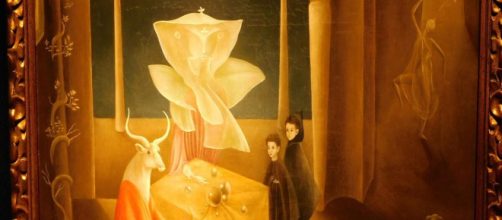Bias against female artists runs on, even seeping into an abbreviated bio of Surrealist Leonora Carrington. She’s in the news this week because MoMA hung one of her paintings in its Surrealist gallery.
The lowdown
Squeezed into her condensed life story Artsy.net managed to add that she was the “one-time romantic companion and muse of the Surrealist Max Ernst.” Of course, she was more than a source of inspiration to another artist. Art News makes clear that Carrington was so intent on her own artmaking that she kept at it until her last day in 2011 at age 94, despite suffering Alzheimer’s.
Weak link
Linking female painters to the male painters they lived with is an old art writing habit. You see it routinely in stories about, say, Lee Krasner (Jackson Pollock’s wife) and Francois Gilot (who lived with Picasso). Whatever famous artist a female painter slept with gets a mention. This even occurs when sex is not consensual. I’m thinking of latter-day reviews of paintings by Artemesia Gentileschi that invariably come with stories of being raped by her art teacher Agostino Tassi.
Ancient times
It wasn’t always like this. The ancient Roman historian Pliny the Elder named several women artists of his time, including Timarete, Eirene, Kalypso, and Olympias without naming men in their lives, although no one mentions these artists anymore.
Carrington raised the issue of sexism herself in an interview with The Guardian in 2007. She said that Miró once handed her a few coins and told her to go buy him a pack of cigarettes. “I gave it back and said if he wanted cigarettes, he could bloody well get them himself. I wasn’t daunted by any of them.”
Making amends
Likely there are Miro’s still out there in the art world asking their fellow female artists to run errands for them. But as Art News points out, at least museums are trying to make amends by putting women’s work on display. This would account for why Carrington suddenly appears on MoMA’s wall with the better-known Miro, Magritte, and Dali.
Say what?
Her picture on exhibition, titled Then We Saw the Daughter of the Minotaur, describes a woman - half-human, half-animal - gesturing to two children to approach some crystal ball set on a table while a phantom-like figure does a jig in the background.
Don’t ask.
This is vintage Carrington acting out her dreams. If you had questions about her work, she wouldn’t answer. As she told the New York Times in 2002, “I am as mysterious to myself as I am mysterious to others.”
Inner reality
One thing is clear, though, while she disregarded reality, the reality of her inner life had her complete attention. And, if you think of Surrealism as a rebellion against what is readily apparent, MoMA's website suggests that she was probably pushing back against the societal expectations of her upbringing as a Catholic and an upper-class female. Instead of debutante balls, she preferred reading Jonathan Swift, Leis Carroll, and Beatrix Potter.
Clearly, fantasy meant a lot to her. MoMA cites art historian Susan Aberth remembering how Carrington was able to recite long passages of Lewis Carroll rhymes into her nineties.


